
Answer
439.5k+ views
Hint: Five orbitals are represented with respect to the coordinate axis in which the orbitals are placed.
- One of the d-orbitals is different from the remaining orbitals.
Complete step by step answer:
So in the question we are asked to comment on the shape of the five d-orbitals i.e. ${{d}_{xy}},{{d}_{xz,}}{{d}_{yz,}}{{d}_{{{x}^{2}}-{{y}^{2}},}}{{d}_{{{z}^{2}}}}$
First let’s look at what the orbital means in chemistry.
- If we take the atomic theory and quantum mechanical approach of an atom, the orbital is the mathematical function which describes the location or position of an electron and explains the wave-like behavior of electrons in the atom.
- And this function is used for the calculation of the probability of finding electrons in the specific area in an atom. Orbitals are referred to as the three dimensional area near the nucleus of an atom where we have the possibility of finding electrons.
- Each orbitals have its own unique set of quantum numbers for n, l, m and s, which gives the energy, angular momentum, magnetic momentum and spin of the electron in the orbital.
- Now let’s see about the d-orbitals.
d-orbitals are introduced from the third shell i.e. with n value as 3.
If n = 3 .we know that,
l (angular momentum quantum number)= (n - 1) = 3 - 1 = 2, which represents the d-orbitals.
And if value of l is 2 then m, magnetic quantum number which gives the number of orbitals have the value from,
m = -l to +l i.e. -2 to +2 values which consists of -2,-1.0, 1 and 2
So in total there are five d-orbitals.
- Now let’s talk about the shape of the d-orbitals-
- Four orbitals of the d-orbitals are having double dumbbell shape whereas one of the d-orbital is different from the four and possessing a single dumbbell shaped structure.
-The four orbitals having double-dumbbell shapes are ${{d}_{xy}},{{d}_{xz,}}{{d}_{yz}} and \,{{d}_{{{x}^{2}}-{{y}^{2}}}}$ and the other one ${{d}_{{{z}^{2}}}}$ is having a single –dumbbell shaped structure.
The orbital’s subscript gives the idea of in which coordinate plane the orbitals are found and the probability of finding the electron.
The shape of the d orbitals are as follows,
- Shape of ${{d}_{xy}}$
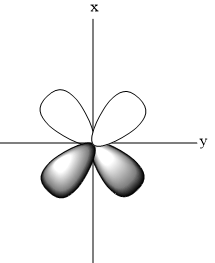
- Shape of ${{d}_{\begin{smallmatrix}
zx \\
\end{smallmatrix}}}$
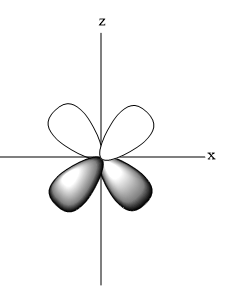
- Shape of ${{d}_{\begin{smallmatrix}
yz \\
\end{smallmatrix}}}$
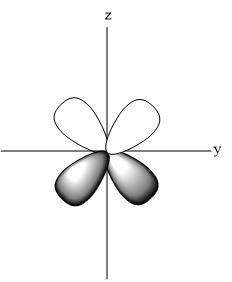
- Shape of ${{d}_{{{x}^{2}}-{{y}^{2}}}}$
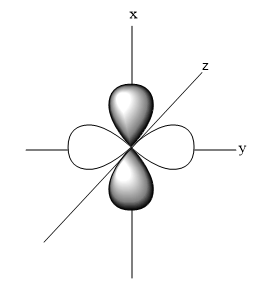
- Shape of ${{d}_{{{z}^{2}}}}$
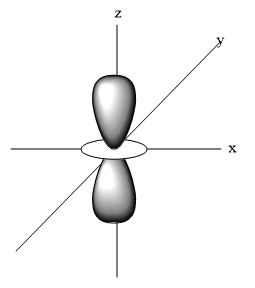
So the correct answer is “a”:
Note: All the d-orbitals are degenerate in nature i.e. all the d-orbitals have the same energy and if any ligands approach them they are split into two sets -${{t}_{2}}_{g}\, and \,{{e}_{g}}$.
- One of the d-orbitals is different from the remaining orbitals.
Complete step by step answer:
So in the question we are asked to comment on the shape of the five d-orbitals i.e. ${{d}_{xy}},{{d}_{xz,}}{{d}_{yz,}}{{d}_{{{x}^{2}}-{{y}^{2}},}}{{d}_{{{z}^{2}}}}$
First let’s look at what the orbital means in chemistry.
- If we take the atomic theory and quantum mechanical approach of an atom, the orbital is the mathematical function which describes the location or position of an electron and explains the wave-like behavior of electrons in the atom.
- And this function is used for the calculation of the probability of finding electrons in the specific area in an atom. Orbitals are referred to as the three dimensional area near the nucleus of an atom where we have the possibility of finding electrons.
- Each orbitals have its own unique set of quantum numbers for n, l, m and s, which gives the energy, angular momentum, magnetic momentum and spin of the electron in the orbital.
- Now let’s see about the d-orbitals.
d-orbitals are introduced from the third shell i.e. with n value as 3.
If n = 3 .we know that,
l (angular momentum quantum number)= (n - 1) = 3 - 1 = 2, which represents the d-orbitals.
And if value of l is 2 then m, magnetic quantum number which gives the number of orbitals have the value from,
m = -l to +l i.e. -2 to +2 values which consists of -2,-1.0, 1 and 2
So in total there are five d-orbitals.
- Now let’s talk about the shape of the d-orbitals-
- Four orbitals of the d-orbitals are having double dumbbell shape whereas one of the d-orbital is different from the four and possessing a single dumbbell shaped structure.
-The four orbitals having double-dumbbell shapes are ${{d}_{xy}},{{d}_{xz,}}{{d}_{yz}} and \,{{d}_{{{x}^{2}}-{{y}^{2}}}}$ and the other one ${{d}_{{{z}^{2}}}}$ is having a single –dumbbell shaped structure.
The orbital’s subscript gives the idea of in which coordinate plane the orbitals are found and the probability of finding the electron.
The shape of the d orbitals are as follows,
- Shape of ${{d}_{xy}}$

- Shape of ${{d}_{\begin{smallmatrix}
zx \\
\end{smallmatrix}}}$

- Shape of ${{d}_{\begin{smallmatrix}
yz \\
\end{smallmatrix}}}$

- Shape of ${{d}_{{{x}^{2}}-{{y}^{2}}}}$

- Shape of ${{d}_{{{z}^{2}}}}$

So the correct answer is “a”:
Note: All the d-orbitals are degenerate in nature i.e. all the d-orbitals have the same energy and if any ligands approach them they are split into two sets -${{t}_{2}}_{g}\, and \,{{e}_{g}}$.
Recently Updated Pages
How is abiogenesis theory disproved experimentally class 12 biology CBSE

What is Biological Magnification

Explain the Basics of Computer and Number System?

Class 11 Question and Answer - Your Ultimate Solutions Guide

Write the IUPAC name of the given compound class 11 chemistry CBSE

Write the IUPAC name of the given compound class 11 chemistry CBSE

Trending doubts
Proton was discovered by A Thomson B Rutherford C Chadwick class 11 chemistry CBSE

What organs are located on the left side of your body class 11 biology CBSE

State the laws of reflection of light

What are ekaboron ekaaluminium and ekasilicon class 11 chemistry CBSE

Three moles of B2H6 are completely reacted with methanol class 11 chemistry CBSE

The third harmonic in an open organ pipe is known as class 11 physics CBSE




